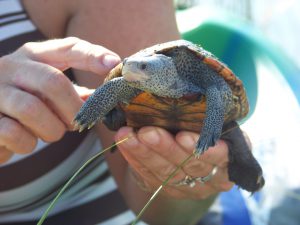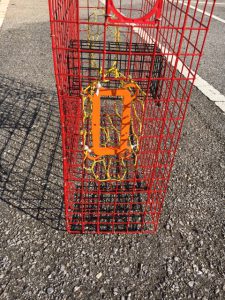We have a lot of really cool and interesting creatures that live in our bay, but one many may not know about is a small turtle known as a diamondback terrapin. Terrapins are usually associated with the Chesapeake Bay area, but actually they are found along the entire eastern and Gulf coast of the United States. It is the only resident turtle of brackish-estuarine environments, and they are really cool looking.

Photo: Molly O’Connor
Terrapins are usually between five and 10 inches in length (this is the shell measurement) and have a grayish-white colored skin, as opposed to the dark green-black found on most small riverine turtles in Florida. The scutes (scales) of the shell are slightly raised and ridged to look like diamonds (hence their name). They are not migratory like sea turtles, but rather spend their entire lives in the marshes near where they were born. They meander around the shorelines and creeks of these habitats, sometimes venturing out into the seagrass beds, searching for shellfish – their favorite prey. Females do come up on beaches to lay their eggs but unlike sea turtles, they prefer to do this during daylight hours and usually close to high tide.
Most folks living here along the Gulf coast have not heard of this turtle, let alone seen one. They are very cryptic and difficult to find. Unlike sea turtles, we usually do not give them a second thought. However, they are one of the top predators in the marsh ecosystem and control plant grazing snails and small crabs. During the 19th century they were prized for their meat in the Chesapeake area. As commonly happens, we over harvested the animal and their numbers declined. As numbers declined the price went up and the popularity of the dish went down. There was an attempt to raise the turtles on farms here in the south for markets up north. One such farm was found at the lower end of Mobile Bay.
Early 20th century still found terrapin on some menus, but the popularity began to wane, and the farms slowly closed. Afterwards, the population terrapins began to rebound – that was until the development of the wire meshed crab trap. Developed for the commercial and recreational blue crab fishery, terrapins made a habitat of swimming into these traps, where they would drown. In the Chesapeake Bay area, the problem was so bad that excluder devices were developed and required on all crab traps. They are not required here in Florida, where the issue is not as bad, but we do have these excluders at the extension office if any crabber has been plagued with capturing terrapins. Studies conducted in New Jersey and Florida found these excluder devices were effective at keeping terrapins out of crab traps but did not affect the crab catch itself. Crabs can turn sideways and still enter the traps.

Photo: Rick O’Connor
Another 20th century issue has been nesting predation by raccoons. As we began to build roads and bridges to isolated marsh islands in our bays, we unknowingly provided a highway for these predators to reach the islands as well. On some islands, raccoons depredated 90% of the terrapin nests. Today, these turtles are protected in every state they inhabit except Florida. Though there is currently no protection for the terrapin itself in our state, they do fall under the general protection for all riverine turtles; you may only possess two at any time and may not possess their eggs.
Some scientists have discussed identifying terrapins as a sentinel species for the health of estuaries. Not having terrapin in the bay does not necessarily mean the bay is unhealthy, but the decline of this turtle (or the blue crab) could increase the population of smaller plant grazing invertebrates they eat throwing off the balance within the system.
Sea Grant trains local volunteers to survey for these creatures within our bay area. Trainings usually take place in April and surveys are conducted during May and June. This year we will be training volunteers in the Perdido area on April 10 at the Southwest Branch of the Pensacola Library on Gulf Beach Highway. That training will begin at 10:00 AM. For Pensacola Beach the training will be on April 15 at the Navarre Beach Sea Turtle Conservation Center on Navarre Beach. That training will begin at 9:00 AM. For more information on diamondback terrapins contact me at the Escambia County Extension Office – (850) 475-5230 ext. 111.
 0
0
